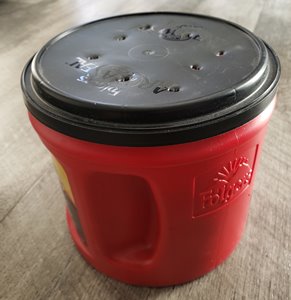
This past Friday (Mar 19 – Day 140) I made the decision to give my two remaining worms a serious housing upgrade – moving everything from the teen tiny WSWB system to a new coffee can system.
I feel that “Phase I” of the experiment has run its course – clearly demonstrating that available space can indeed have a major influence on population growth. This might seem like “common sense”, especially when testing with such a tiny system – but it’s still an important point to demonstrate. Many people assume, even worry, that their worm population will just grow and grow forever! (The mental image of a bin literally overflowing with worms always makes me chuckle)
I wasn’t overly surprised about the lack of population growth – but one thing that did surprise me was that there didn’t seem to be any obvious cocoon production.
Funny enough…
What did I find very quickly when I opened up the system the other day?
Yep, cocoons!

It seems there were at least a few produced since the last “official” assessment (mid Feb) – but I did also casually check on the bin 2 or 3 times since then. So, my hunch is that these were recently deposited.
My original prediction (about expecting to find cocoons) was based on the fact that these worms are very well adapted for life in frequently-changing, sometimes harsh, environments. When environmental conditions signal challenges ahead (eg. dropping temps in outdoor systems), cocoon production often increases.
This was an interesting scenario in that the worms were actually born into this environment. My guess is that adults added to a bin this size would drop cocoons a lot more quickly (than these ones did even once fully mature).
Seeing that they have finally dropped some makes me even more glad I had decided to discontinue the experiment (at least in the tiny bin). My hunch is that this was more of an overall population-survival strategy than the result of healthy breeding activity.
The remaining 2 worms did end of reaching a similar, decent (“normal”) Red Worm size. Note: the lower image is misleading since the worm wasn’t fully extended.


The new coffee tub system set-up was pretty basic. Lots of moistened, shredded brown paper and cardboard. I emptied the contents of the tiny bin into the middle zone.

I also moistened up all the remaining micro-bedding and some dried up food scraps, along with some dried kale, and added this mix to the new bin.

I gently mixed everything in the new system to help distribute moisture (and food materials) more evenly and to reduce pooling down in the bottom.

I punched some holes in the lid with a pencil, but I’ve been keeping the lid partially open so as to not take any chances with the kale this time around. Even with all that air flow (and the tiny amount of kale actually added), some pretty pungent odors have been wafting out.
During my gentle mixing process I wasn’t able to locate either of the worms. My curiosity got the better of me this morning and I ended up dumping everything out for a closer examination. I’m happy to report that I found both worms (looking very healthy)!
I will be very interested to see how the population develops from here!
Not really sure what to call this series moving forward, since there’s no chance that a coffee can is the “World’s Smallest Worm Bin” – lol. I think I will just use “WSWB”, and I’ll continue to include links to previous posts in the series so everyone knows how it all started.
Stay tuned – more to come!
😎
Previous Posts in Series
Smallest Worm Bin – Day 105
Smallest Worm Bin – Day 50!
Smallest Worm Bin – 11-09-20
The World’s Smallest Worm Bin?
